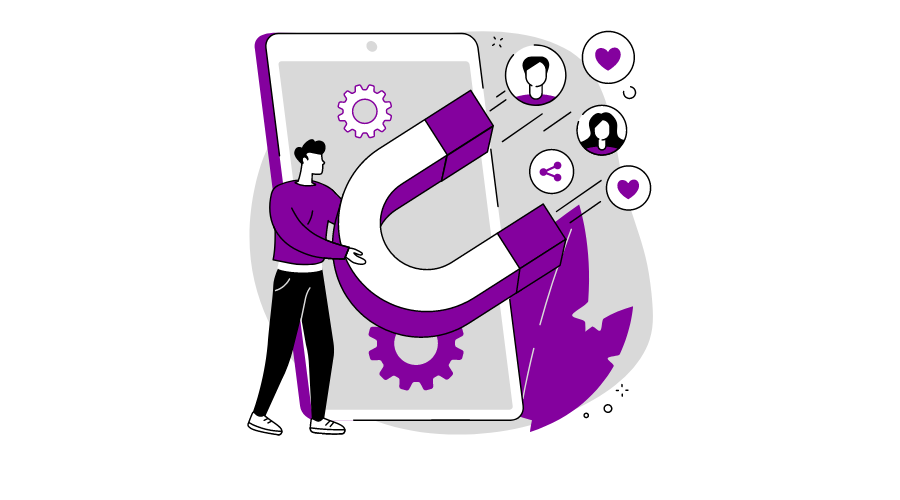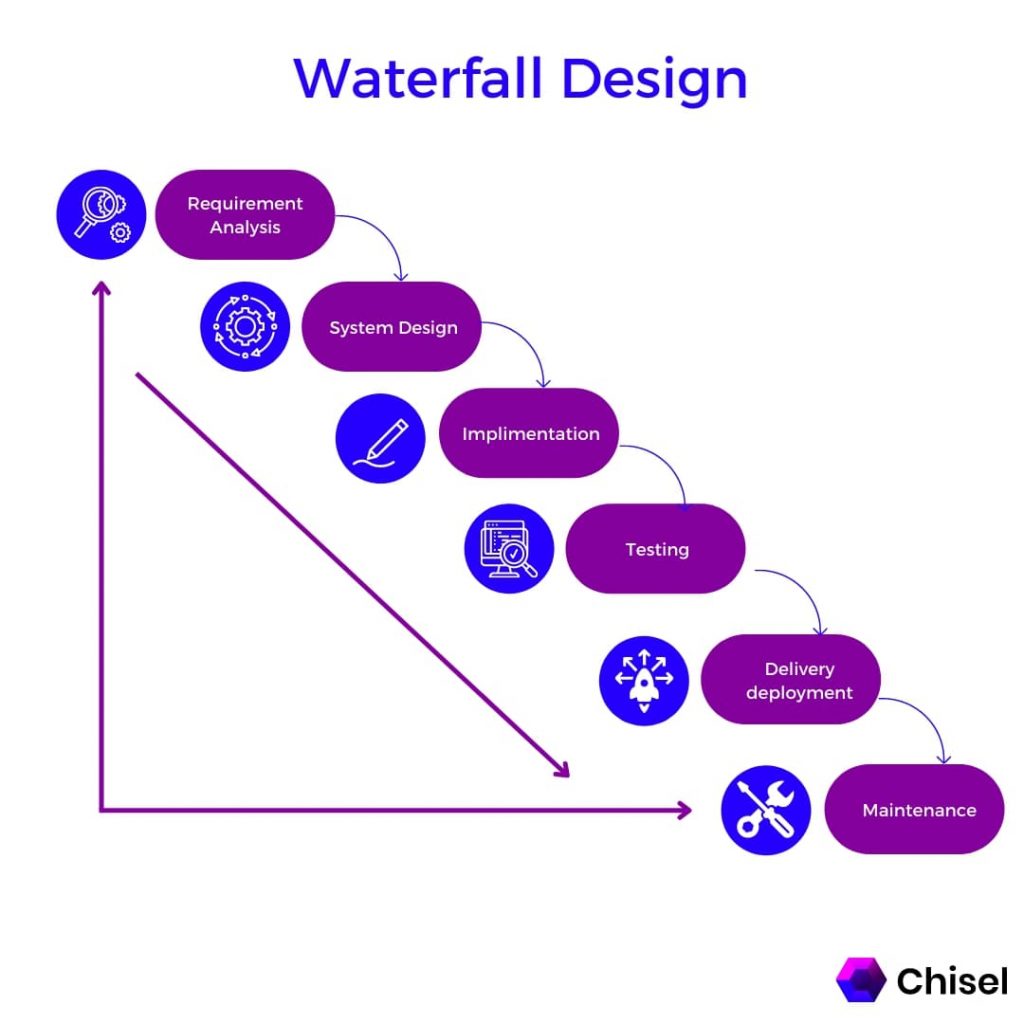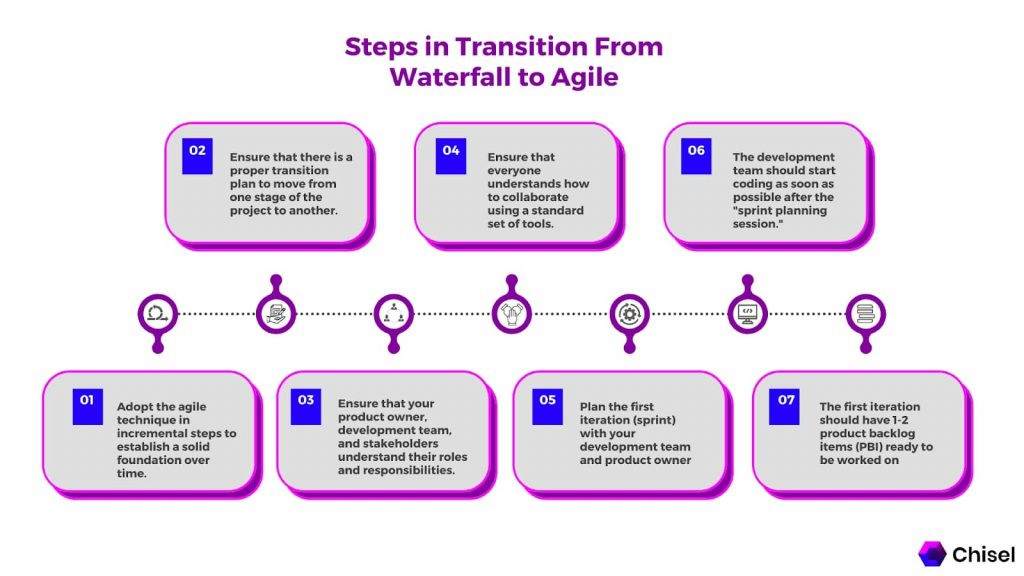Waterfall to Agile: Why & How to Make the Switch

This article covers:
- Why Should We Switch to Agile From Waterfall?
- How To Move From Waterfall to Agile?
- What Are the Reasons for Waterfall to Agile Transition?
- What Are the Steps You Have To Take In Transition From Agile to Waterfall?
- How Does Agile Transitioning Affect the Product Roadmap?
- What Are the Challenges an Organization Faces While Moving From Waterfall to Agile?
- When To Use Agile vs. Waterfall?
- Conclusion
Waterfall methodology refers to a product development process that is linear and sequential, where a project’s activities must get completed in a particular order.
Waterfall has many perceived benefits:
- It ensures higher-quality output than other methods,
- Provides rich documentation for future reference and
- Allows team members to focus on specific tasks without worrying about what comes next.

On the other hand, agile methodology refers to a product development process that is iterative and incremental, where the activities of a project get completed in any order.
Agile is on the rise because it encourages faster delivery of working software, provides more flexibility to meet changing needs, and allows for early feedback from customers.
For many years, the waterfall methodology was the preferred method among businesses for product development. However, it faces several problems that agile methodology can handle more effectively.
Hence, let’s look at why you need to change your approach from waterfall to agile.
Why We Should Switch to Agile From Waterfall?
The waterfall methodology lacks to deliver on a promise. It is among the prime reasons for the modern-day shift.
The waterfall has downsides. It is impossible to identify all requirements at the start of a project. It can take a long time for feedback from users to get incorporated into a project due to the long time required for testing and bug fixes. Also, requirements may change during development.
Hence, the transition from waterfall to agile is fast becoming the talk of the town.
There are too many reasons for this transition, but one of the prime ones is how technologies change these days.
Waterfall to agile has led to companies exploring newer methodologies to deliver on their promise before time. This waterfall transition fits in perfectly with the same.
How To Move From Waterfall to Agile?
The transition from waterfall to agile happens as follows:
As the first step, you look at your current project and note down all the areas of concern.
If the analysis is thorough, you should know what matters and how the transition will fit into the picture.
The next step is to do a complete transition from waterfall to agile.
Finally, follow the transition plan/policy you have in mind or created.
Let’s delve deeper and discuss three primary reasons for the transition from waterfall to agile.
What Are the Reasons for Waterfall to Agile Transition?
Risk Curve in Agile Is Flat as Opposed to the Rising Risk Curve of the Waterfall
Waterfall workflows are sequential. Hence they (sequential phase-wise workflows) require you to complete one phase before starting the next.
It means that the risks of each phase get accumulated in bucket ‘A.’ As in, the waterfall methodology works sequentially by bucket accumulation. Thereby, this makes the curve of the waterfall a constant rise.
In agile, you tend to agglomerate all the possible risks during sprint planning. In daily scrums, you create a combined bucket ‘B.’
As in agile, you distribute the risk amongst multiple sprints or iterations. It makes the curve of agile more flat.
Almost Perfectly Level in Agile Beats the Tyranny of Perfection in Waterfall
The waterfall makes you perfect by preventing any modifications to the final product. And waterfall makes it necessary for you to test thoroughly and quality checks the product.
Whereas in agile, no product, no project is perfect. Hence, you timebox iterations or sprints to meet the minimum viable product. A team of engineers, designers, and testers performs this quality assessment.
It makes agile more flexible and feasible.
Business Stays in Loop in Agile as Opposed to in Waterfall
In waterfall, the business doesn’t have to know what is going on in your garbage pit, which may make room for more mistakes.
However, with agile, the business will receive iterative increments of work.
Hence, reducing the risk of errors and maintaining a great relationship with them.
What Are the Steps You Have To Take In Transition From Agile to Waterfall?
Step 1
Adopt the agile technique in incremental steps to establish a solid foundation over time.
The best way to go about this is by coming up with a small part of the project. Also, using agile practices such as scrum, extreme programming, or kanban.
You can then add on more functionality later when you have gained experience implementing agile.
Step 2
Ensure that there is a proper transition plan to move from one stage of the project to another.
For example, all unfinished stories after an iteration should get placed in the backlog for future iterations.
All bugs or tasks identified during development can either be moved to the next iteration or closed out entirely as long as they aren’t get fixed soon.
Step 3
Ensure that your product owner, development team, and stakeholders understand their roles and responsibilities.
Do not assume anything. Ask everyone to read the agile manifesto if you have to.
Step 4
Ensure that everyone understands how to collaborate using a standard set of tools. Ensure that everyone is aware of other communication channels such as mailing lists, IRC, and Skype.
Step 5
Plan the first iteration (sprint) with your development team and product owner. Let them know what to expect from the first iteration and plan accordingly based on their availability and skill set. A good length for a “sprint” (the term for an iteration) is 1-2 weeks.
Step 6
The development team should start coding as soon as possible after the “sprint planning session.”
Let them know that your goal is to have a small but working subset of features by the end of the first sprint also that they can choose their task.
Step 7
The first iteration should have 1-2 product backlog items (PBI) ready to be worked on at the start of the sprint. That is, with up to 4 additional PBIs estimated for future sprints (based on the goal of having a group of ~4-5 PBIs ready before each sprint).

How Does Agile Transitioning Affect the Product Roadmap?
A product roadmap can ease the process of transitioning from waterfall to agile.
Using product management softwares, you can further break down agile product roadmaps into smaller segments achievable within one sprint.

Agile product roadmaps are valuable for teams transitioning to agile because they help break down complex features into smaller projects. Various product roadmap tools can help product managers here.
It allows agile transitioning to focus on 1-3 elements at a time which helps to ensure agile transitioning progress rather than additional resources not being available.
Embrace the Process of Transition From Waterfall to Agile
The transition from waterfall to agile is not easy. But it is something everyone should do. Agile methodologies are changing how people work, think and get things done.
Embrace these changes by moving towards an agile process of development. Being able to respond quickly to your customers can be a decisive competitive advantage in today’s hyper-competitive environment.
Successful transition requires a significant change in how an organization thinks and operates.
Suppose your company is not prepared to take on this challenge. You are better off staying with what you have because making the transition will be costly, time-consuming, and painful without the proper preparation.
Of course, no process is complete without facing some challenges. Following are some common challenges that organizations face when transitioning to agile development.
What Are the Challenges an Organization Faces While Moving From Waterfall to Agile?
No Clear Business Case/ROI to the Organization and Customers on Why We Should Be Moving to Agile
The above refers to the transition just because others are doing it, without regard for how this will impact ROI or competitive advantage. It is typically a common challenge in larger organizations with multiple leadership teams with competing views on short vs. long-term ROI.
Agile Is Like a Silver Bullet To Fix the Organization’s Problems
It is a common misconception amongst management teams. Agile is just one of many changes required, including organizational culture change and process reengineering.
Several more obstacles within the organization need to be dealt with proactively to introduce this significant change.
Agile Is Too Hard and Not Worth the Effort
Many have tried, but few have succeeded in implementing true agile at scale across multiple teams and business units within an organization.
It’s a journey you need to take because it has a lasting impact on your culture that will transcend many generations of product development.
Agile Is Not a Panacea
Although agile provides the means to improve problems in your organization, it doesn’t offer answers concerning how you should implement them.
There are many ways to address anyone’s problem that could be at odds or even conflict between themselves. For example, there are many ways to improve code quality.
When To Use Agile vs. Waterfall?
The waterfall is the ideal choice for reliable projects. Since it involves extensive planning at the outset, considering all factors (both externally and internally) that can affect the project’s execution.
The waterfall is the best option, regardless of the project’s size, when the external factors are constant and unlikely to alter over the plan.
The waterfall is best suited to projects with precise deadlines and deliverables. The waterfall is generally the best strategy if your primary project limitations are fully understood and documented.
The waterfall was the ideal approach for these projects before agile came along, and it is still today.
If you can design a project ahead of time in a low-risk environment, dividing it into numerous sprints to offer value each week isn’t necessary. It’s best to concentrate on the end product as soon as possible.
Since the project gets planned out from the start, the budget for projects employing Waterfall techniques is less flexible.
For instance, waterfall approaches could be a valuable methodology to follow if a project owner has a clear and defined vision for an app. And feels convinced that it will not alter throughout the project development.
On the other hand, agile approaches projects demand a more flexible process due to their unpredictability and instability.
Agile allows for a lot of flexibility in adapting and changing direction as the project progresses. It’s appropriate for initiatives where the conclusion may rely on additional research or testing.
Since agile allows for more flexibility in project direction as the project progresses, the budget is also liable to vary.
Suppose the product vision and components are subject to change due to external circumstances (such as market dynamics). It is preferable to design and modify the product utilizing agile.
It is preferable to avoid letting the project lingered in development for months before the delivery of the final product. After each sprint, there will also be a checkpoint where the product owner will provide feedback.
The intention of the agile technique is for projects with many restrictions that aren’t well known.
Determining the scope and timing ahead of time may be challenging if your project consists of creating a new product. Agile allows you to organize a project in stages or “sprints,” allowing it to develop as the work advances.
Similarly, using “Kanban boards,” you can facilitate higher team collaboration and transparency, improving your team’s productivity.
The lack of adequate checkpoints in changing projects that use waterfall adds risk because it’s more difficult to resolve potential faults discovered near the conclusion of development.
The extra time set aside for project planning does not guarantee that the design and development phases will flow smoothly till the end because most challenges are as undesirable as they are unpredictable.
Selecting between waterfall and agile should be more than a marketing decision. It should consider all factors influencing a project and how well-defined a product is.
Choosing the incorrect tool for the work can result in additional time and effort.
Conclusion
We understand the main gist of why your organization needs this transition and the step-by-step process of transitioning from waterfall to agile. We hope you can apply this to your organizational structure and change it for good.
Adapting the new trends and technologies is crucial because they will help you grow the organization and give it a competitive edge.
We assure you that this transition will change your organization for good.
